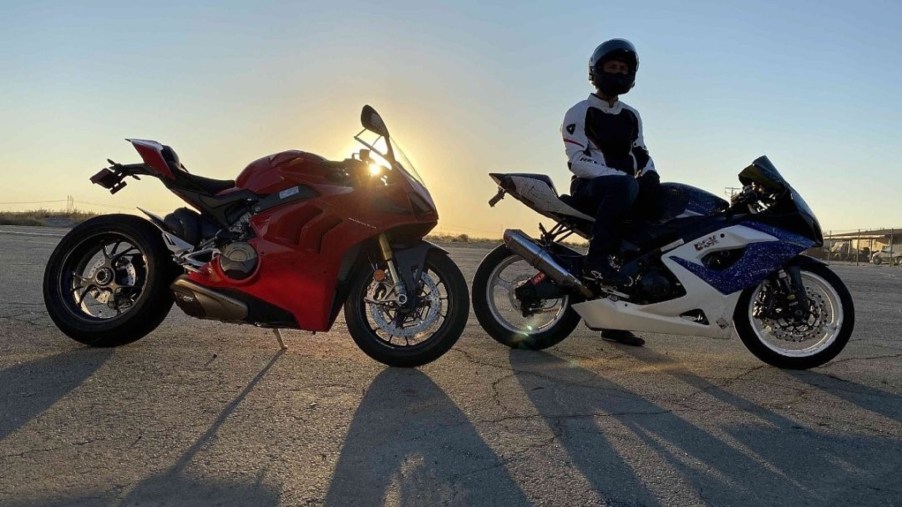
A 15-Year-Old Suzuki GSX-R1000 Can Keep up With a Ducati Panigale V4
While its motorcycles aren’t the most expensive, Ducati’s bikes are arguably some of the most desirable. Especially its Panigale line of sportbikes. The V2 model is quick in its own right and keeps the manufacturer’s L-twin tradition alive. But if you want the closest thing to a commuter-friendly Desmosedici RR, you’ll need the Ducati Panigale V4 S. However, if you want the speed but don’t have the green, a used Suzuki GSX-R1000 may be just as fast.
How do the 2005 Suzuki GSX-R1000 and 2020 Ducati Panigale V4 S stack up?
On the face of it, a match between a 2020 Ducati Panigale V4 S and a 2005 Suzuki GSX-R1000 may seem to favor the Italian bike.
For one, the Panigale V4 is more powerful than the ‘Gixxer.’ The Ducati has an 1103cc V4 producing 186 hp and 80 lb-ft at the rear wheel, Motorcyclist reports. At the crank, it makes 214 hp and 92 lb-ft. In contrast, the ‘K5’ Suzuki GSXR-1000’s 999cc four-cylinder makes 157 hp and 80 lb-ft at the rear wheel, Cycle World reports.

Secondly, the 2020 Ducati Panigale V4 S is more advanced, features-wise, than the K5 Suzuki GSX-R1000. The latter has a slipper clutch, fuel injection, disc brakes, a gear indicator, and that’s about it, Cycle World, and Bennetts report.
In contrast, the Panigale V4 S has semi-active Ohlins dampers, adjustable ABS, Brembo brakes, and a TFT dash, Cycle World reports. It has traction control, wheelie control, slide control, and even engine-braking control. The Ducati Panigale V4 S also has an electronic quick-shifter, and for 2020, aerodynamic winglets from the V4 R. The latter are plastic, though, rather than carbon-fiber.
However, the 2005 Suzuki GSX-R1000 does have one advantage: weight. With all its fluids, the Panigale V4 S weighs 430 pounds. And while there’s an optional titanium exhaust that cuts 13 pounds and adds 12 hp, it’s not street-legal. Meanwhile, the K5 Gixxer weighs in at 366 pounds. That makes it roughly 50 pounds lighter than my 2012 Triumph Street Triple R—which is down about 50 hp.
2005 Suzuki GSX-R1000 vs. 2020 Ducati Panigale V4 S: racetrack riding

The real test of these 2 super sport bikes is at the racetrack. Which is exactly where Revzilla’s Zack Courts and Ari Henning went to test them. On the way, though, the duo also rode the bikes on city and back-country streets and the highway. There, they found the GSXR-1000 throws less heat than the Panigale V4, though the newer bike has a better throttle response.
Admittedly, the 2005 Suzuki GSX-R1000 the hosts tested wasn’t completely stock. It had a new shock, a rebuilt braking system, new footpegs, and clip-on handlebars. Also, many of the wear components were replaced or refreshed. And to give the Gixxer even a slight advantage, on the track it initially rode on Pirelli racing slicks. The Ducati Panigale V4 S, meanwhile, rode on Pirelli Supercorsa SP tires.
Turns out, though, the slicks weren’t necessary. Going back and forth between Courts and Henning, the Suzuki GSX-R1000 was faster around Buttonwillow Raceway’s West Loop than the Panigale. Even after fitting the Gixxer with the same Supercorsa tires as the Ducati, it was still 1-2 seconds faster around the track.
There is one caveat to this story, though. It turns out that the 2020 Ducati Panigale V4 S the hosts rode had the wrong rear spring installed. That may account for the slower lap time compared to the Suzuki GSX-R1000, as well as the decreased precision the duo encountered.
Pricing and buyer’s guide
Nevertheless, these results bring up an interesting point.
It’s possible, Jalopnik muses, that a professional rider could’ve set a faster time on the Ducati. But Courts and Henning, while skilled, aren’t pros. While the newer Panigale has more performance-related features, the average rider won’t necessarily take full advantage of them. Admittedly, that makes it a safer commuter than the K5 Suzuki GSX-R1000. But if you want to get into track riding, you don’t have to buy an expensive bike to do it. Sometimes, an older, simpler, and cheaper motorcycle is just as quick.

And a K5 Suzuki GSX-R1000 is indeed cheap. It’s possible to find examples on Cycle Trader for $5000-$7000. In contrast, the 2020 Ducati Panigale V4 S starts at $28,395. However, if you want the last truly electronics-free Gixxer, Bennetts recommends the 2012-2014 models, which have Brembo brakes. They typically go for under $10,000 on Cycle Trader.
But, if you want a bit of extra safety equipment, the 2015 Gixxer was the first to feature ABS, Cycle World reports. And in 2017, it received traction control, a low-RPM assist feature, an LCD dash, and a fuel gauge, Cycle World reports. The 2017 R adds launch control and a standard bi-directional quick-shifter to that. The latter became standard on the base model in 2020, Motorcyclist reports.
Follow more updates from MotorBiscuit on our Facebook page.


